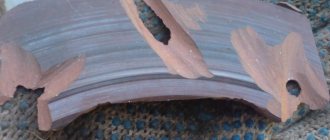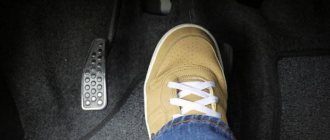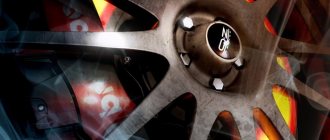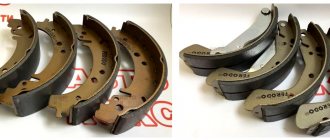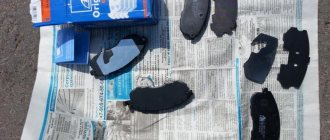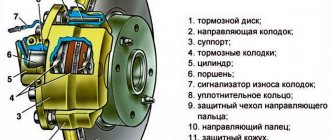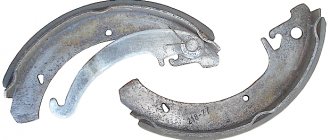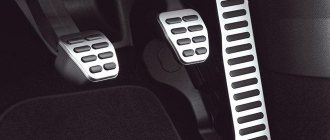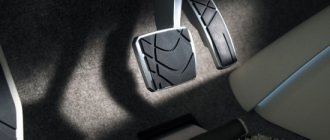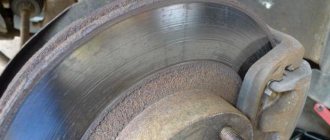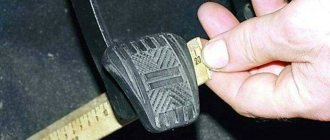Even such a simple operation as replacing brake pads is essentially a repair intervention in the most important safety system. You need to know all the subtleties and possible consequences of the process, which many people underestimate and, after completing the work, may be unpleasantly surprised by the consequences.
One of the troubles that appeared was the failure (softness) of the pedal all the way to the floor instead of the usual viscous and powerful braking.
Mono: how to change car brake fluid for one person without assistance
There is only one way to solve the question of how to replace brake fluid for one person. His goal is to update the composition in the tank and lines without using the help of a partner. The features of this method are similar to bleeding the brakes:
- To speed up the process, it is recommended to immediately remove the working emulsion from the expansion tank using a bulb or a syringe with a tube attached.
- The preparatory stage consists of purchasing 1 liter of brake fluid and a 1 meter long tube, suitable in diameter to the outlet fittings on the brake cylinders. You will also need a cut-off bottle with a certain amount of working fluid so that air does not pass through the fitting into the system.
- During the process of replacement/pumping, the composition gradually leaves the tank. The level must be replenished regularly, otherwise the system will become airy.
Process technology
The essence of the replacement is the flow of the working fluid under the influence of gravity. After all, the tank is at the highest point. In fact, the operation is no more difficult than checking the injectors of a diesel or gasoline engine. As a result, the set of actions is as follows:
- Empty the expansion tank and fill it with new fluid up to the MAX limit mark.
- Clean all 4 drain fittings and install tubes on them. Place the latter in plastic containers with “brake fluid”.
- Unscrew all the drain fitting nuts one by one:
- right rear;
- left rear;
- right front;
- left front.
- While watching how the composition drains, do not forget to add a new drug to the tank.
- When the volume of liquid poured from the left front wheel reaches approximately 200 ml, tighten the fittings on it and on all other cylinders in the reverse order:
- front left;
- front right;
- rear left;
- rear right.
- Restore the fluid level in the tank.
- Clean the fitting and put a tube on it, lowered into the brake fluid.
- Create pressure in the retarding system.
- Unscrew the union nut and wait until the liquid pressure decreases to low.
- Close the fitting.
- Repeat until liquid comes out without bubbles.
Leveling up
The method is relevant if there is no air in the deceleration system. If there are air bubbles in the unit, the emulsion will not drain under the influence of gravity. Excessive pressure is required to bleed it off - just like in production. In this case, replacing the composition comes down to bleeding the brakes:
Excessive pressure in the system can be created in several ways:
- Find an assistant or pump the brake pedal yourself and press it with a gas stop from the hood/trunk installed between it and the seat.
- Insert the syringe with the emulsion into the lid of the tank and seal it. Having opened the fitting, press the syringe pusher.
- Install the car nipple into the cover. Seal with sealant or superglue. Remove the nipple and install the tube. Install the opposite end of the hose onto the quick-release tip of the pump. Take excess pressure from the spare tire. You can do it even simpler - apply pressure from the compressor to the spool.
The brake pedal fails (the brakes are too soft)
It is worth noting that if you feel weak braking when pressing the brake of a VAZ 2109 or any other model, you need to think about the fact that these may be features of a particular vehicle. Perhaps you just moved from another car, so you feel some discomfort while driving a new car.
On the other hand, such a symptom can also occur when air enters the system. It should be noted that in the event of depressurization of the system, the pipeline may completely burst and completely fail. This can be corrected by bleeding the brakes. At the same time, you should diagnose the cylinders, check the level of the brake fluid, as well as its quality (often air gets into the brake system simply because there is too little fluid) and perform a full check of the vehicle (the latter will help determine the presence of hidden problems) ;
If the pedal becomes soft after replacing the brake fluid, then, as a rule, the problem lies in the use of a low-quality mixture. Alternatively, it is possible that air got into the system during replacement - this is also worth paying attention to.
It is also quite common for the pedal to feel soft after bleeding the brakes. First of all, you should bleed the master cylinder. As a rule, this solves a similar problem. Alternatively, there may be problems with the anti-lock braking system (if equipped). In any case, if the brakes are soft after bleeding, you should approach this task responsibly. Perhaps you should contact specialists who can quickly and effectively fix the problem.
Video about the operating principle of the brake master cylinder:
Where to dig: the brake pedal on a car fails and the brake fluid does not leave the reservoir
The fear of a sunken pedal often occurs among beginners. After all, they don’t really know the design of this unit. Meanwhile, there is nothing to be afraid of if the vacuum amplifier comes into operation. Usually he does this after starting the engine. If you press on the lever at this moment, it will fail when you start the engine, and it will instantly become easier to operate.
It's worth sounding the alarm when a running power plant exhibits a malfunction in the form of the brake pedal sinking and the brake fluid not leaving the reservoir anywhere. If she had left, the diagnosis would have been made immediately - a leak in the system.
However, the problem posed is known to all mechanics. Its essence is that there is air in the system. It is not recommended to ignore the symptom. It is better to immediately stop using the car or, if this happened in the garage, not to leave. In this case, you should take into account the rules. According to them, towing a car with an automatic transmission or robot, and in this case with a manual transmission is also prohibited - it is impossible to slow down. A tow truck with a full or partial load is the only option to get to the service station or home.
The way to solve the problem is to bleed the system. The process has already been described and is quite feasible at home. In technology, it is important to follow the schematic. It wouldn’t hurt to repeat the pumping scheme 3-5 times.
Often, when a pedal fails, the ABS system is blamed. However, this is erroneous - it does not affect the initial operation of the deceleration unit. You can simply check this yourself by deactivating the ABS and driving in a safe area. The conclusion of the test drive will be negative - the problem will not go away.
Let's sum it up
Taking into account the above, it becomes clear that any deviations from the norm in the operation of the brake system (either a soft brake pedal, a hard brake pedal, or a combination of problems) require immediate diagnosis. After identifying the malfunction, it is necessary to properly eliminate the problem.
You also need to promptly change the fluid, bleed the brakes, inspect the brake hoses for defects and leaks, install new brake pads, discs or drums in a timely manner, lubricate the brake caliper guides, etc. This approach will allow you to safely operate the car and achieve high-quality performance of the braking system in any conditions.
The brake pedal falls to the floor, the brakes disappear unexpectedly, after replacing the brake fluid, pads, brake discs: the main causes of the malfunction.
Reasons why the engine may stall when you press the brake. The power unit stalls during sudden braking, when the clutch and brake are depressed, etc.
What is engine braking? How to perform this technique correctly. Pros and cons, sleep recommendations. Engine braking on cars with automatic transmission.
How to brake correctly in a car with a manual transmission: types of standard braking on a manual transmission, emergency and emergency braking, tips.
The clutch pedal has fallen: why does this happen? The main reasons why the clutch pedal fails, what should the driver do if the clutch fails.
Driving a vehicle always involves various risks. A high-quality braking system can avoid most of them. Thus, if you find a hard or soft brake pedal, you need to immediately address this problem. If such problems arise, you should not delay; it is better to conduct a thorough diagnosis to find out what exactly is the cause of the problem.
Problem: after replacing the brake fluid on the car, the pedal became soft and uninformative
By changing the brake fluid, the car enthusiast fulfills one of the requirements of routine maintenance on the car. Namely, replace the fluid after two to three years. The manufacturer confidently states that if this is not done, it will be bad. In fact, the emulsion is hygroscopic and can “grab” moisture from the air during this time. Of course, this will negatively affect the functioning of the system as a whole. Safety comes first - we change. We fueled everything up, tightened it up, started it up and drove off. And then we notice that after replacing the brake fluid, the pedal became soft and uninformative. What to do? There are several reasons for this problem floating around the web:
- The system is filled with low-quality components.
- The replaced elements of the assembly did not get used.
- The system is poorly pumped.
The first feature is more often a myth than a reality. The second one can appear when replacing the pads due to the fact that they have not gotten used to the disk and are pressed into the grooves of the groove. There are two ways out - wait 900-1,000 km until everything breaks in or sharpen the discs to get an instant effect. However, most often the problem of a soft pedal is associated with other problems:
- The main brake cylinder is not bled.
- The brake force distributor between the rear and the front is not pumped (sorcerer) - this does not apply to all cars.
- One of the components of the assembly is leaking (fuel fluid will leave the tank).
- One of the rubber hoses is inflated.
Why does the pedal fail after replacing the pads?
To understand the essence of what is happening, you need to clearly understand, at least on a physical level, how the car’s brake system works. What exactly should happen after pressing the pedal, and what happens after erroneous actions.
The pedal rod creates pressure in the brake lines through the main hydraulic cylinder. The fluid is incompressible, so the force will be transmitted through the working cylinders in the calipers to the brake pads, and they will press against the discs. The car will begin to slow down.
The clamping force on the pads should be significant. The coefficient of friction of the linings on the cast iron or steel of the disk is not very high, and the friction force is determined precisely by its product times the pressing force.
From here, the hydraulic transformation of the system is calculated, when a large pedal movement leads to a small pad stroke, but there is a significant gain in force.
All this leads to the need to place the pads at a minimum distance from the disc. The self-feeding mechanism works, and the surfaces of the pads and disc that come into contact must be perfectly smooth.
After replacing the pads at first, all normal operating conditions will be violated:
- when removing old parts and installing new parts, the pistons of the working cylinders were recessed into the calipers as much as possible, otherwise, due to the difference in the thickness of the pads, installation would be impossible; the fresh pads fit with a non-standardized gap;
- the old pads were worn in to the discs, as a result of which there was a relief on all surfaces, but its depressions and protrusions coincided with the mating surface, this had almost no effect on the work;
- new parts will have to contact the worn-out disc for some time, not with the entire surface, but only with the protrusions, before breaking-in;
- Even if new, smooth discs are installed, the ideal mating of the surfaces will not occur immediately; braking efficiency will decrease, which means the pedal travel will increase.
All this will lead to two undesirable effects. After the first press, the pedal will fail and there will be no deceleration. The stroke of the cylinder rod is spent moving the pads to the discs; several presses may be required due to the large conventional gear ratio of the drive.
In the future, the pedal will be softer than usual, and the brakes will be less viscous due to incomplete contact of the pads with the discs.
This is interesting: How to bleed ABS brakes for one person
In addition, some pads have such a property that in order to enter the operating mode they need to warm up thoroughly and acquire the necessary qualities of the lining material, which will increase the coefficient of friction to the calculated one, that is, the usual one.
Is it possible to add brake fluid from another manufacturer or brand to the reservoir?
Going to buy 1 liter of TJ – it would seem that there’s nothing special about it. I came to the store, ordered, paid and went to the garage with a satisfied look. This was the case before, when out of all the auto chemical enterprises there was only one in the news - the Dzerzhinsky plant. Now you can not only easily confuse diesel and gasoline oil, but also the composition of the braking system. After all, in the market, even experts sometimes get their eyes wide open. Here you have Rosdot, and Sintec, and a bunch of other similar names.
What will an unscrupulous driver do? He’ll take any one and go with the idea of quickly resolving the issue. Motorists are rushing to warn against such indifference. The mixing operation is, of course, permissible, and the manufacturer even indicates with what compounds his product can be used. The question is whether it is possible to add brake fluid of another brand when the consumer is not aware of the origin of the emulsion already filled.
Undoubtedly, the code for the current composition can be found in the instruction manual. What if it is lost, or the car is bought secondhand? In general, if the situation is unclear, it is recommended to completely change the working fluid. What you definitely shouldn’t do is pour in TF with a low boiling point. Dangerous.
#1 Gladiator
Our locomotive fly forward!
Good afternoon. Now that I have time, I want to work on the brakes.
There is a pressing problem - low braking (slowdown) efficiency and a soft brake pedal.
Those. There seem to be brakes, but for a critical situation they are clearly too weak - I may not have time to stop. Those. I press the pedal (at least to the floor) and it slows down slowly. There is not even any talk about use.
By analogy with a bicycle - there are those in which you press on the pedal and the rear wheel is blocked until the black stripe on the asphalt, and on the other - you press - but you won’t stop quickly, there is no effective deceleration (that’s how it is for me).
1. The brakes are bled. True, the sorcerer did not stick a screwdriver into it, but he loaded the trunk with 100 kg.
2. The front cylinders were sour. I treated it a little with castor oil. When driving without braking, they do not jam, the discs are cold. When driving around the city, they work. After the trip, the discs are warm (the front right and rear left are hotter than the front left and rear right). The rear right disc is the coldest. When braking, the car does not go anywhere. There is no vibration.
3. GTZ costs Pilenga. The vacuum rod was not adjusted. If you stand at a traffic light and keep your foot on the brake, the pedal does not go down, i.e. The GTZ doesn't seem to let it through.
4. When the car is not started, it is impossible to pump up the brake pedal. Previously, after several pumping motions, its stroke became less and less and the pedal became stuck. Now this is not the case. True, if you start the engine with the pedal pressed, it goes down a little. Well, when pumping up the pedal, it hisses a little - it wheezes. True, when running, the engine speed does not change when swinging.
5. The brake hoses are new (Lukas), the brake fluid is fresh, there are no leaks anywhere.
Hard or soft brake pedal: what is the reason and what to do
As you know, the safe operation of any vehicle directly depends on the proper operation of the braking system. At the same time, the driver may notice that at some point the car brakes worse, extraneous noise appears during braking, the brake pedal sinks, the brake pedal becomes hard or soft, etc.
In any case, if the brake pedal is hard to press or the brake pedal is soft and does not brake the car well, you must immediately stop using the car, determine the cause and eliminate the problem. Next, we will look at why the brake pedal is hard to press, the brakes are too soft, or the brake pedal is either soft or hard.
The main reasons for a soft or stiff brake pedal and methods for solving them
In most cases, the brake pedal becomes soft due to problems with the master cylinder or vacuum booster. It is much cheaper and easier to systematically diagnose brakes, so as not to spend money on repairs later. Because brakes fail at the most inopportune times, remember this.
The brake pedal must be pressed with increased force for several reasons:
- The vacuum booster air filter is clogged. In this case, the air filter must be replaced; · the valve body in the vacuum booster is stuck, there is only one way out - replace the vacuum booster;
- it may be that the diaphragm in the vacuum amplifier is damaged, then the amplifier needs to be changed;
- malfunction of the tip of the vacuum booster - you need to change the tip;
- the check valve in the vacuum booster does not work or is stuck, so fuel enters the cavity of the vacuum booster. In this case, it is necessary to change not only the vacuum booster, but also the check valve;
- The hose that connects the vacuum booster and the intake manifold is damaged, or the hose fastening in the fitting is loose.
You will need to change the hose or tighten the mounting clamp. If we talk about the vacuum booster hose, then you need to constantly monitor its condition. Especially in winter. The hose will be quite stiff until it is warmed up. The brakes work fine. The hose will heat up after the engine has been running for a short time, and it will become more elastic. If the delamination of the hose is not noticeable, its throughput will decrease.
There may be problems with the brake pedal;
O-rings in wheel (working) cylinders may swell. This can happen if fuels and lubricants get into them or if low-quality brake fluid is used. Brake fluid and wheel cylinders should only be replaced with those recommended by the manufacturer.
The brake pedal is too soft
If pressing the pedal has become too soft, it means there are air bubbles in the hydraulics and then the system should be pumped, or there is a loss of working fluid. The first thing you need to do is check the brake fluid level. If it is below the permissible level, the hydraulic system must be carefully checked for leaks. A leak may occur at the connection points between the tubes and fittings due to poorly clamped clamps, and the hoses themselves may be damaged. Working fluid can also be lost in wheel brake cylinders if the seals are damaged. After eliminating the leak, you will also need to bleed the brake system hydraulics to remove air from it.
If the brake fluid is of poor quality, contaminated, or has not been changed for a long time and has lost its properties, then heating during sudden braking can quite easily lead to its boiling, and then the brakes will become “wobbly” and the car itself will be difficult to control. An old, dirty, or inadequate brake fluid can cause seized brake cylinders, damaged seals, and other problems. The conclusion is obvious - pay attention to the condition of the brake fluid and change it in a timely manner.
Another reason for a soft brake pedal is the hoses, which are made of rubber and wear out over time, becoming loose. When hydraulic pressure builds up during braking, they simply inflate. As a result, the brakes become too soft and braking becomes less effective.
An extreme and very dangerous manifestation of soft brakes is pedal failure. This occurs due to significant leakage of fuel fluid or damage to the sealing rings in the gas turbine engine.
An excessively soft brake pedal, and even more so if it fails, requires an urgent solution to the problem. You need to stop immediately, braking with the engine or handbrake, and then find and correct the problems.
Methods for checking a vacuum booster
There are several ways to check the vacuum booster. First you need to start the engine. A vacuum will be created in the system. Next they press the brakes. If the brake pedal is hard, then there is a fault in the hose or booster. You need to turn off the engine and wait 5 minutes, but do not apply the brakes.
To specify the malfunction, you need to press the pedal. If it continues to be hard, then in most cases there is a problem with the vacuum booster valve.
There is another way. The engine must be turned off. To relieve the vacuum in the brake system, press the brake pedal several times. Then the engine is started, but the brake pedal is not released. If the pedal goes down, then there is no problem with the amplifier.
The second problem is the soft brake pedal. This may indicate several malfunctions at once. More precisely, there are several reasons why the brake pedal can become soft. Soft brakes mean the brake pedal sinks.
Why is the brake pedal higher than the gas pedal?
Drivers often wonder why on many models all the pedals in the car are not on the same plane. As a rule, on a car with an automatic transmission, the brake pedal is noticeably higher than the gas pedal. On cars with manual transmission, the clutch and gas are also often lower than the brake.
Let us note that there is a lot of debate on this matter and there are a number of conjectures and assumptions. Some car enthusiasts claim that this is inconvenient, others complain that if the pedals were in the same plane, it would be easier to control the car, etc.
Let’s also add that some owners believe that the brake pedal is placed higher in order to increase its travel, and also taking into account the need for more force (lever).
Scheme for pumping brakes on a VAZ-2110
The brake system of the VAZ-2110 has two circuits operating in a diagonal pattern. This dictates the procedure for removing air from the system. When performing work, it is necessary to follow the following pumping sequence:
- Right rear wheel.
- Front left.
- Rear left.
- Front right.
The procedure for bleeding the brake system of the VAZ-2110 and modifications.
Necessary materials
Before you start bleeding, you need to stock up on brake fluid for topping up.
It is important to remember that the liquid must be the same brand that was used previously. If we are not sure what kind of brake fluid is poured into the VAZ-2110 system, it is better to play it safe and replace it completely . Otherwise, when mixing fluids of different types, clots may form in the system, which will damage the brakes.
Also for work you will need a transparent container half filled with liquid, a hose for the fitting about 40-50 cm long, a socket wrench with a cut out segment (union wrench).
Bleeding the brakes with an assistant
An assistant will be needed. Go.
- Open the lid of the fluid reservoir and add it to the maximum allowable mark.
Remove the protective cap from the fitting of the right rear wheel.
Block the "sorcerer" if necessary.
We put the hose on the fitting, connect it to the container and pour brake fluid into it.
We bleed the remaining brake mechanisms in order of priority.
Next, we bleed the brake mechanisms of the remaining wheels, according to the bleeding order.
We pump the brakes ourselves, without an assistant
If you couldn’t find an assistant, no problem.
To bleed the brakes alone, you will need a reservoir cap, a hose and a tubeless tire nipple.
We'll bleed it ourselves, but to do this you need to stock up on an old-style brake reservoir cap, without a fluid level indicator. You will also need a regular nipple from a car camera and a 14mm drill. Drill a hole in the center of the cover and insert the nipple. The device is ready. Let's move on to pumping:
- Add liquid to the tank to the maximum.
- We close the tank with our lid with a nipple.
Screw the cap and gasket onto the tank.
We attach the other end of the hose to the camera nipple.
For convenience, you can embed a faucet from the pneumatic system into the hose.
The brake pedal has gone to the floor - what to do?
If the brake pedal becomes soft, that is, it begins to sink significantly, you should immediately check the entire brake system of the car. Most likely, diagnostics will be required at a service center and further repairs.
The main thing is to contact the service center in time
It is important to remember that all malfunctions of this kind are fraught with consequences. Brakes with a defect can fail while driving; this can probably happen on a busy avenue; such a car can only be stopped even at an average speed by colliding with some other vehicle or structure. If the brake pedal is easy to press, there may be several reasons:
- the brake cylinder is not able to hold fluid and the corresponding pressure; there may be significant wear on the cuffs and rubber gaskets;
- the wrong fluid has been filled into the brake tank;
- there are problems with the pads or discs;
- there are defects in the operation of the vacuum pump;
- The traction pedals may exhibit rust.
Problems with the brake system are clearly indicated by the presence of vibration, hissing and tapping in the pedal when it is pressed.
How to remove the vacuum brake booster of a VAZ 2110
We remove the vacuum booster and brake pedal assembly after removing the engine compartment upholstery, trim and windshield trim.
- Replacing the vacuum brake booster on a VAZ 2110. The reason for the replacement was that a hissing sound appeared when pressing the brake pedal, which could cause the engine to stall at any moment, the brake pedal became tight. To replace the vacuum booster, it is necessary to disassemble the rear wall of the engine compartment; remove the rubber seal (1), unscrew the upholstery (2) and remove the frill (3).
- Disconnect the block from the brake fluid level sensor, disconnect the hose from the vacuum booster, and unscrew the two nuts of the brake master cylinder.
- After that, carefully remove the main brake cylinder (without unscrewing the brake pipes) from the vacuum booster to a distance sufficient to remove the vacuum booster.
- Inside the car, under the dashboard (under the instrument panel), unscrew the four nuts and remove the wires from the frog. The most difficult thing in replacing the vacuum booster is unscrewing these four nuts, they are very inconveniently located.
- We remove the vacuum booster along with the pedal assembly.
- Remove the locking plate and push out the vacuum pusher mounting pin.
- Unscrew the vacuum booster from the pedal assembly.
- We install a new vacuum booster, pay attention to the correct installation, the pedal is at the bottom, and the hose fitting is at the top. Next we assemble in reverse order.
Lada VAZ-2110 (2111, 2112). Increased brake pedal travel (brake pedal falls through)
Reasons for increased brake pedal travel
| Inspect all lines, their threaded connections and cylinders, and eliminate leaks. Restore the normal fluid level in the brake reservoir and bleed the system. If you find damage to the brake hoses (cracks, swelling or traces of brake fluid), replace the hoses. If you suspect defects in the master brake cylinder, replace it with a good one. | |
| The rubber cuffs of the cylinders are swollen due to oil, gasoline, etc. getting into the brake fluid. | Replace cylinders, hoses, completely drain the brake fluid, flush the system with fresh fluid and bleed |
| Overheating of brake mechanisms | Allow the brakes to cool. Use only DOT-4 brake fluids in the system. Replace brake fluid promptly |
| The gap between the pads and the drum has been increased (the automatic gap adjustment device does not work) | Replace the wheel cylinder, bleed the system |
| One of the circuits of the service brake system does not work | Eliminate fluid leakage from the brake system, bleed the system |
| Leak in the brake master cylinder | Fix the leak |
| Loss of elasticity of the internal rubber bands of the brake master cylinder | If you suspect defects in the master brake cylinder, replace it with a good one. |
| Increased (more than 0.15 mm) runout of the brake disc | Replace both drives |
The brake pedal falls off after starting the engine
There may be several reasons for such a malfunction. Quite often, diagnostics must begin with checking the brake fluid level in the reservoir. Any hydraulic system has the specified compensation tank. The tank has “min” and “max” marks, which determine the normal amount of fluid in the system.
The fact is that although the brake fluid is incompressible, the volume of fluid in the system changes. This occurs due to the fact that brake pads tend to wear out during use. As a result, the RTC pistons extend further to move the pads, which requires more fluid in the system. For this reason, the minimum level of working fluid in the tank is determined. When the amount of fuel fluid drops below the minimum, then air enters the brake system circuit, that is, airing occurs.
If the brake pedal fails, the causes of such a malfunction can often be a critical decrease in the fluid level or air ingress. When pressed, the brake pedal goes to the floor all the way, the brakes do not work completely or barely work. To prevent possible consequences, the level of brake fluid in the expansion tank must be checked visually, without waiting for the moment when the emergency lamp lights up on the instrument panel in the cabin.
If the ABS brake pedal suddenly fails or the pedal falls to the floor on cars without an anti-lock braking system, and checking the fluid level in the reservoir does not give anything (the level is normal), then overheating of the brakes may be the culprit. Brakes overheat in cases where there is intense and frequent braking at high speeds, constant and prolonged driving at low speed with the brake pedal pressed (for example, descents on mountain serpentines). More often, deterioration of the system in such modes occurs in conjunction with high outside ambient temperatures.
After replacing the brake pads, the brake pedal fails
New brake discs and brake pads should be worn in. While the grinding is not completed, the car may jerk after pressing the brake, the brake pedal begins to vibrate, and when braking, light vibrations can be transmitted to the steering wheel. Let us add that the general grinding in of new pads and discs takes from 250 to 400 km. mileage If the symptoms do not stop, then you should check the quality of the parts and the correct installation of the elements.
A common cause of brake problems, where the brake pedal slowly sinks, is a damaged or misaligned brake caliper that is present in the design of the brake system. The displacement of the vertical axis of the caliper relative to the axis of the brake disc does not allow the system to work normally. Also, the caliper may be in good working order, but poorly secured. In such cases, the brake pads are simply not able to properly rub into the disc.
When the engine is running, the brake pedal falls down
The most common reasons for the brake pedal to fail when the car is running are air in the system, problems with the turbocharger, low fuel fluid level, critical wear of the pads/discs, overheating of the brakes, etc.
When the brake pedal does not fall, but remains very stiff after starting and the effectiveness of the brakes is greatly reduced, then the brake booster should be checked. Additionally, its malfunction is indicated by the fact that the engine speed fluctuates when you press the brake, although the fluid does not leave the brake system reservoir, and also when the engine is turned off, the brake pedal always remains elastic, and not after several presses.
The brake pedal fails: the brake fluid does not drain
If there is a leak, the brake system inevitably becomes airy. It turns out that if the brake pedal sinks, but the fluid does not leave, this does not mean that the system is sealed. Two or three drops of fuel oil will not affect the level in the reservoir, the leak itself may be difficult to detect, but the brakes will not work properly.
Brake fluid may be leaking through the master cylinder, but the leak can only be detected by disconnecting the master cylinder from the brake booster. It often happens that the cylinder is not completely filled.
After changing the brake fluid, the brake pedal fails
First of all, this may mean that air remains in the system.
If the brake pedal fails after repair, then there is a high probability that errors were made during assembly, the system is not pumped well enough, there are brake fluid leaks, etc.
Brakes lost after heavy braking
The reason may be a break in the brake hoses, tubes, or breakdown of the brake cylinders (main or working). The brake pedal also drops sharply when there is severe wear on the discs or brake drums or brake pads. In this case, the piston of the working cylinder is pushed out.
Another reason may be overheating of the brake fluid during very active braking (brake overheating).
content .. 141 142 143 144 ..
Solving the problem of a soft pedal
So, the most common problem is poor, low-quality fluid, due to the fact that it may not be suitable for a certain car model, and corrosion of the hoses may gradually appear. Rubber elements are not able to withstand such liquid; they delaminate and increase in diameter, which leads to loss of tightness. If the brake pedal has become soft, it is best to undergo diagnostics of the entire brake system and defective elements.
The second reason is rust in the rods. There is only one way out - replacing them completely. You can determine such a malfunction by holding down the brake pedal; if it remains down and you have to “lift” it with improvised tools, there is definitely a problem in the rods.
The incorrect gap between the pedal and the cylinder is also determined by the pedal being clamped. If pressing immediately occurs easily and smoothly, and at the end the applied force has to be doubled, most likely the gap is incorrectly adjusted; the pressure present does not allow the pedal to be lowered and raised normally. You will have to adjust and bleed the brakes.
Air locks also cause a lot of trouble, appearing due to wear and tear of the hoses; they lead to breakdowns in the vacuum pump. The brake cylinders lose some of the pressure, the pads do not move apart, and therefore cannot press against the disc. The pads should be checked to see if they are damaged.
